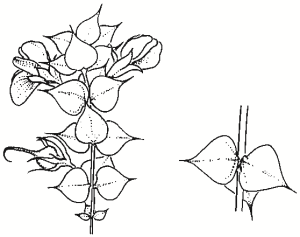Family:
Fabaceae
Pultenaea cunninghamii
Grey Bush-pea
Other Names:
First Nations Name(s):

Name Origin:
Pultenaea — after Richard Pulteney (1730-1801), English botanist.
cunninghamii — after A. Cunningham, Australian explorer.
Regional Subspecies:
Occurrence:
Regional:
Predominantly east of the Olympic Highway. Noted in the areas:
Bowna-Jindera; Yambla; Talmalmo-Murray; Scent Bottle-Serpentine-Upper Yarra Yarra; Coppabella; Lower Adelong and Upper Gilmore and Sandy.
Australia:
Qld, NSW, Vic.
Habitat:
Dry sclerophyll woodland to forest, generally on sandy or stony soil.
Habit:
Erect spreading shrub 50 cm to 2 m high. Drooping branchlets, grey-green leaves pointed at tips. Growing tips often pink/orange.
Site Preference:
Well-drained soil in partial sun. Tolerates drought and frost.
Flowering:
Yellow-orange with red, Oct-Dec. Usually flowers for 4-6 weeks.
Seed Collection:
Mid Oct to late Feb. Monitor closely as seeds shed immediately or within 1-2 days of maturity.
Propagation:
From scarified seed, or cuttings of firm young growth (rooting hormones should improve strike rate). Pour boiling or very hot water over seeds and soak until water cools. Dry to prevent rotting and sow. Germination takes 3-4 weeks. Suitable for direct seeding in pots (2-3 seeds per pot).
Regeneration:
From seed, particularly after fire.
VALUES:
Shade & Shelter:
Useful low-level cover in windbreaks. Important understorey component.
Land Protection:
Legume — improves soil fertility through ‘fixing’ nitrogen.
Wildlife:
Good habitat. Flowers are a nectar source for native wasps and bees. Wallabies graze foliage.
Ornamental:
Attractive ornamental. Interesting, colourful foliage.
